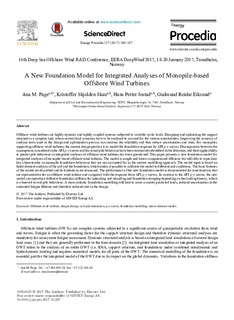A New Foundation Model for Integrated Analyses of Monopile-based Offshore Wind Turbines
Peer reviewed, Journal article
Published version
Permanent lenke
http://hdl.handle.net/11250/2484331Utgivelsesdato
2017Metadata
Vis full innførselSamlinger
- NGI articles [1061]
Sammendrag
Offshore wind turbines are highly dynamic and tightly coupled systems subjected to variable cyclic loads. Designing and optimizing the support structure is a complex task, where several load scenarios have to be analysed to account for the various uncertainties. Improving the accuracy of analysis tools used in the design and optimization process can increase the reliability and thus reduce uncertainties and risks. For monopiles supporting offshore wind turbines, the current design practice is to model the foundation response by API p-y curves. Discrepancies between the assumptions considered in the API p-y curves and the actual pile behaviour have been extensively identified in the literature, and their applicability to predict pile behaviour in integrated analyses of offshore wind turbines has been questioned. This paper presents a new foundation model for integrated analyses of monopile-based offshore wind turbines. The model is simple and hence computational efficient, but still able to reproduce key characteristic in monopile foundation behaviour that are not accounted for in the current modelling approach. The model input is based on finite element analyses of the soil and the foundation, which makes it possible to calibrate the model to different soil conditions. The basic features of the model are described and its limitations are discussed. The performance of the new foundation model is demonstrated for time histories that are representative for an offshore wind turbine and compared with the response from API p-y curves. In contrast to the API p-y curves, the new model can reproduce different foundation stiffness for unloading and reloading and foundation damping depending on the loading history, which is observed in real pile behaviour. A more realistic foundation modelling will lead to more accurate predicted loads, reduced uncertainties in the estimated fatigue lifetime and therefore reduced risk in the design.
